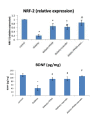Targeting Altered Mitochondrial Biogenesis in the Brain of Diabetic Rats: Potential Effect of Pioglitazone and Exendin-4
- PMID: 32274400
- PMCID: PMC7103073
Targeting Altered Mitochondrial Biogenesis in the Brain of Diabetic Rats: Potential Effect of Pioglitazone and Exendin-4
Abstract
Background: Neuroprotective mechanisms triggered by peroxisome proliferator-activated receptor-gamma agonist: pioglitazone (PIO) and glucagon-like peptide 1 analog: exendin-4 (Ex-4) in neurological diseases were reported, but whether mitochondrial biogenesis is involved or not in their neuro-protective mechanisms in type 1 Diabetes Mellitus (T1DM); has not been studied before. To bridge this gap, we investigated the effect of PIO and Ex-4 on brain mitochondrial biogenesis in streptozotocin- induced diabetes in rats.
Methods: Seven weeks after induction of diabetes in rats, serum fasting glucose and insulin were measured in studied groups. The brain was removed for histological analysis and assessment of: mitochondrial complexes I and II, ATP, H2O2, brain derived neurotrophic factor (BDNF), cytochrome c and hemeoxygenase (HO)-1 activity, and relative gene expression of the nuclear factor; Nrf2 and the apoptotic markers: bax & bcl2 and mitochondrial biogenesis markers; peroxisome proliferator-activated receptor γ coactivator (PGC) 1-α and sirtuin 1 (SIRT-1) and AMP-activated protein kinase (AMPK) and c-Jun-N-terminal kinase (JNK) proteins.
Results: Brain in untreated rats showed neurodegeneration area and significantly rising H2O2 and JNK, up-regulation of bax, down-regulation of bcl2. These changes were paralleled with significant reduction in Nrf2, HO-1, BDNF, complex I, II and ATP and SIRT-1/ PGC1-α expression. PIO and Ex-4 significantly improved the reported changes. Combined modality showed better improvement relative to each drug alone.
Conclusion: PIO and Ex-4 may have neuroprotective effects in T1DM, via targeting altered mitochondrial biogenesis probably due to modulation of brain SIRT-1 signaling, improvement of oxidative stress and equilibrating the balance between pro-apoptotic and anti-apoptotic mediators.
Keywords: Brain derived neurotrophic factor; Diabetic neurodegeneration; Exendin-4; PGC1- α; oxidative stress.
Figures




References
-
- Van Elderen SG, de Roos A, de Craen AJ, Westendorp RG, Blauw GJ, Jukema JW, et al. Progression of brain atrophy and cognitive decline in diabetes mellitus. Neurology. 2010;75:997–1002. - PubMed
-
- Blake R, Trounce IA. Mitochondrial dysfunction and complications associated with diabetes. Biochim Biophys Acta. 2014;1840(4):1404–1412. - PubMed
LinkOut - more resources
Full Text Sources
Research Materials
Miscellaneous
